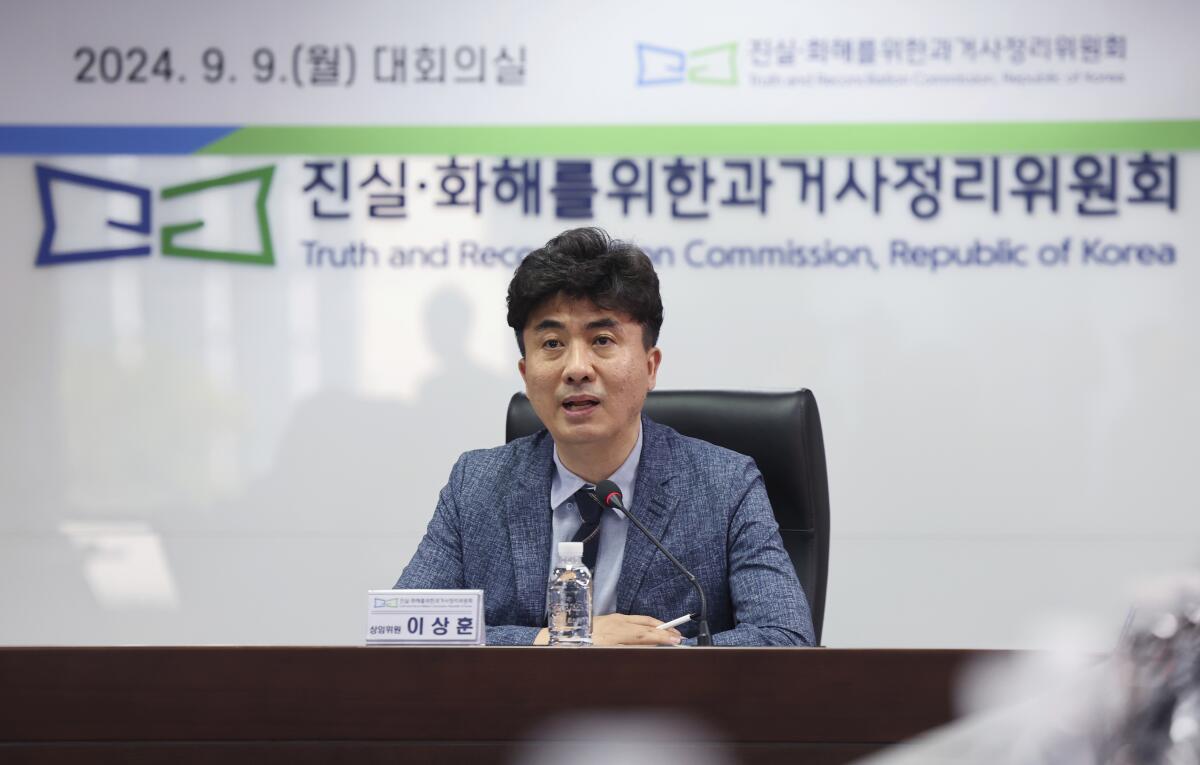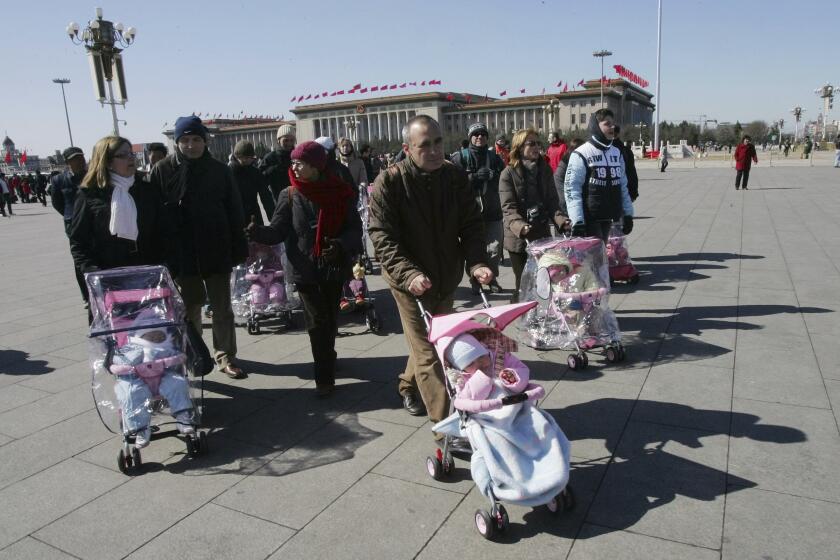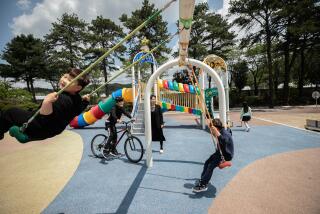South Korean truth commission says it found more evidence of forced adoptions in the 1980s

- Share via
SEOUL — A South Korean commission found evidence that women were pressured into giving away their infants for foreign adoptions after giving birth at government-funded facilities where thousands of people were confined and enslaved from the 1960s to the 1980s.
The report by the Truth and Reconciliation Commission on Monday came years after the Associated Press revealed adoptions from the biggest facility for so-called vagrants, Brothers Home, which shipped children abroad as part of a huge, profit-seeking enterprise that exploited thousands of people trapped within the compound in the port city of Busan. Thousands of children and adults — many of them grabbed off the streets — were enslaved in such facilities and often raped, beaten or killed in the 1970s and 1980s.
The commission was launched in December 2020 to review human rights violations linked to the country’s past military governments. It had previously found the country’s past military governments responsible for atrocities committed at Brothers. Its latest report is focused on four similar facilities in the cities of Seoul and Daegu and the provinces of South Chungcheong and Gyeonggi. Like Brothers, these facilities were operated to accommodate government roundups aimed at beautifying the streets.
Ha Kum Chul, one of the commission’s investigators, said inmate records show at least 20 adoptions occurred from Daegu’s Huimangwon and South Chungcheong province’s Cheonseongwon in 1985 and 1986. South Korea sent more than 17,500 children abroad in those two years as its foreign adoption program peaked.
He is a grown-up now. Yet every time Thomas Park Clement gets a fever, his mind spins backward.
Ha said children taken from inmates at Huimangwon and Cheonseongwon were mostly newborns, who were transferred to two adoption agencies, Holt Children’s Services and Eastern Social Welfare Society, which placed them with families in the United States, Denmark, Norway and Australia. Most of the infants were transferred to the agencies on the day of their birth or the day after, Ha said, indicating that their adoptions were determined pre-birth.
While the facilities’ records say some of the women submitted memos expressing their consent to give away their children, other records indicate women were being pressured to do so, Ha said. A 1985 inmate record from Huimangwon flags a 42-year-old inmate with supposed mental health issues for “causing problems” by refusing to relinquish her child. Officials later note that she eventually did.
“It’s difficult to accurately determine how many more adopted children there might have been in other years,” Ha said, citing the commission’s staff limitations. For Huimangwon, Ha said, the commission was only able to look through its inmate records from 1985 and 1986 and still found 14 adoptions. A further six adoptions were linked to inmates at Cheonseongwon.
At their peak, Huimangwon had about 1,400 inmates and Cheonseongwon 1,200. That was still smaller than the population at Brothers, which exceeded 3,000.
Holt and Eastern did not immediately respond to requests for comment on the commission’s findings.
In era of ethnic pride and the Internet, many foreign children raised by Americans are seeking out birth parents. The odds are slim, and the reunions can be happy or bittersweet.
Through documents obtained from officials, lawmakers or through public information requests, the AP in 2019 found direct evidence that 19 children were adopted out of Brothers between 1979 and 1986, and indirect evidence suggesting at least 51 more adoptions.
About 200,000 South Koreans have been adopted in the United States, Europe and Australia in the last six decades, creating what’s believed to be the world’s largest diaspora of adoptees. Most of the adoptions occurred during the 1970s and ’80s, when South Korea’s then-military leaders were focused on economic growth and saw adoptions as a tool to reduce the number of mouths to feed, erase the “social problem” of unwed mothers and deepen ties with the democratic West.
The commission has also been conducting a separate investigation into the cases of 367 Korean adoptees in Europe, the United States and Australia who suspect their biological origins were manipulated to facilitate their adoptions. It’s expected to release an interim report on that later this year.
The commission also identified other human rights problems at the four facilities it highlighted on Monday, including Gaengsaengwon in Seoul and Seonghyewon in Gyeonggi province. The facilities’ death tolls were high — the 262 inmates who were reported as dead from Gaengsaengwon in 1980 accounted for more than 25% of the facility’s population that year, Ha said.
China will no longer allow international adoptions of its children. The only exception will be for relatives adopting a child or stepchild, a spokesperson said.
Nearly 120 bodies of Cheonseongwon inmates were provided to a local medical school for anatomy practice from 1982 to 1992, the commission said. Most of the bodies were transferred to the school on the day the inmates were declared dead or the day after, and there are no indications that the facility made efforts to transfer the bodies to relatives, according to the commission, which didn’t identify the school.
Huimangwon, Seonghyewon and Cheonseongwon also regularly received inmates transferred from Brothers, suggesting a “revolving-door” labor-sharing scheme among facilities that likely increased profit and prolonged the inmates’ confinements, the commission said.
The population at South Korea’s vagrant facilities peaked in the 1980s as the then-military government intensified roundups to beautify streets ahead of the 1986 Asian Games and the 1988 Olympic Games held in Seoul. South Korea transitioned to a democracy in the late 1980s and has long stopped its practice of grabbing homeless people, the disabled and children off the streets and confining them.
Brothers closed in 1988, months after a prosecutor exposed its horrors. Seonghyewon now runs welfare programs for homeless people in the city of Hwaseong, while the three other facilities have changed their names and the services they provide. None of those facilities immediately released comments following the commission’s report.
“The four confinement facilities had been allowed to continue their operations without receiving any public investigations even after 1987,” when Brothers was exposed, said Lee Sang Hoon, one of the commission’s standing commissioners. “It’s significant that we have comprehensively revealed the details of the human rights violations at [other] vagrant facilities across the country that had been concealed for 37 years.”
Kim writes for the Associated Press.
More to Read
Sign up for Essential California
The most important California stories and recommendations in your inbox every morning.
You may occasionally receive promotional content from the Los Angeles Times.











